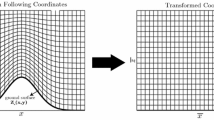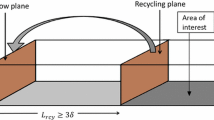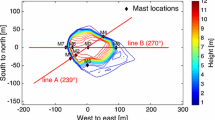Abstract
In the wind-energy sector, wind-power forecasting, turbine siting, and turbine-design selection are all highly dependent on a precise evaluation of atmospheric wind conditions. On-site measurements provide reliable data; however, in complex terrain and at the scale of a wind farm, local measurements may be insufficient for a detailed site description. On highly variable terrain, numerical models are commonly used but still constitute a challenge regarding simulation and interpretation. We propose a joint state-of-the-art study of two approaches to modelling atmospheric flow over the Bolund hill: a wind-tunnel test and a large-eddy simulation (LES). The approach has the particularity of describing both methods in parallel in order to highlight their similarities and differences. The work provides a first detailed comparison between field measurements, wind-tunnel experiments and numerical simulations. The systematic and quantitative approach used for the comparison contributes to a better understanding of the strengths and weaknesses of each model and, therefore, to their enhancement. Despite fundamental modelling differences, both techniques result in only a 5 % difference in the mean wind speed and 15 % in the turbulent kinetic energy (TKE). The joint comparison makes it possible to identify the most difficult features to model: the near-ground flow and the wake of the hill. When compared to field data, both models reach 11 % error for the mean wind speed, which is close to the best performance reported in the literature. For the TKE, a great improvement is found using the LES model compared to previous studies (20 % error). Wind-tunnel results are in the low range of error when compared to experiments reported previously (40 % error). This comparison highlights the potential of such approaches and gives directions for the improvement of complex flow modelling.

















Similar content being viewed by others
References
Allen T, Brown A (2002) Large-eddy simulation of turbulent separated flow over rough hills. Boundary-Layer Meteorol 102:177–198
Astley RJ (1977) A finite element frozen vorticity solution for two-dimensional wind flow over hills. In: Proceedings of 6th Australian hydraulics and fluid mechanics conference, pp 5–9
Baba-Ahmadi M, Tabor G (2009) Inlet conditions for LES using mapping and feedback control. Comput Fluids 38:1299–1311
Bechmann A (2006) Large-eddy simulation of atmospheric flow over complex terrain. Risø-PhD, risø-PhD-28(EN)
Bechmann A, Sørensen NN (2010) Hybrid RANS/LES method for wind flow over complex terrain. Wind Energy 13:36–50
Bechmann A, Berg J, Courtney M, Ejsing Jørgensen H, Mann J, Sørensen NN (2009) The Bolund experiment: overview and background. Danmarks Tekniske Universitet, Risø National Laboratory for Sustainable Energy
Bechmann A, Sørensen N, Berg J, Mann J, Réthoré P (2011) The Bolund experiment, part 2: blind comparison of microscale flow models. Boundary-Layer Meteorol 141(2):245–271
Berg J, Mann J, Bechmann A, Courtney M, Jørgensen H (2011) The Bolund experiment, part 1: flow over a steep, three-dimensional hill. Boundary-Layer Meteorol 141(2):219–243
Bou-Zeid E, Meneveau C, Parlange M (2005) A scale-dependent Lagrangian dynamic model for large eddy simulation of complex turbulent flows. Phys Fluids 17(2):025105
Bowen A (2003) Modelling of strong wind flows over complex terrain at small geometric scales. J Wind Eng Ind Aerodyn 91(12):1859–1871
Bowen A, Lindley D (1977) A wind-tunnel investigation of the wind speed and turbulence characteristics close to the ground over various escarpment shapes. Boundary-Layer Meteorol 12(3):259–271
Bowen AJ (1979) Full scale measurements of the atmospheric turbulence over two escarpments. Wind engineering: proceedings of 5th international conference. Fort Collins, Pergamon, pp 161–172
Brown A, Hobson J, Wood N (2001) Large-eddy simulation of neutral turbulent flow over rough sinusoidal ridges. Boundary-Layer Meteorol 98:411–441
Cao S, Wang T, Ge Y, Tamura Y (2012) Numerical study on turbulent boundary layers over two-dimensional hills–effects of surface roughness and slope. J Wind Eng Ind Aerodyn 104–106:342–349
Castro F, Silva Lopes A (2003) Simulation of the Askervein flow. Part 1: Reynolds Averaged Navier–Stokes Equations (\(k\) turbulence model). Boundary-Layer Meteorol 107(3):501–530
Cermak J (1970) Laboratory simulation of the atmospheric boundary layer. Tech. rep, DTIC Document
Cermak J (1984) Physical modelling of flow and dispersion over complex terrain. Boundary-Layer Meteorol 30(1):261–292
Chaudhari A (2014) Large-eddy simulation of wind flows over complex terrains for wind energy applications. PhD Thesis, Lappeenranta University of Technology
Chaudhari A, Hellsten A, Agafonova O, Hämäläinen J (2014a) Large eddy simulation of boundary-layer flows over two-dimensional hills. In: Fontes M, Günther M, Marheineke N (eds) Progress in Industrial Mathematics at ECMI 2012. Springer International Publishing, Mathematics in Industry, pp 211–218
Chaudhari A, Vuorinen V, Agafonova O, Hellsten A, Hämäläinen J (2014b) Large-eddy simulation for atmospheric boundary layer flows over complex terrains with applications in wind energy. In: 11th World Congress on Computational Mechanics, WCCM 2014, 5th European Conference on Computational Mechanics, ECCM 2014 and 6th European conference on computational fluid dynamics, ECFD 2014, pp 5205–5216
Chock G, Cochran L (2005) Modeling of topographic wind speed effects in hawaii. J Wind Eng Ind Aerodyn 93(8):623–638
Chow FK, Street RL (2009) Evaluation of turbulence closure models for large-eddy simulation over complex terrain: flow over Askervein hill. J Appl Meteorol Climatol 48(5):1050–1065
Conan B (2012) Wind resource assessment in complex terrain by wind tunnel modelling. PhD Thesis, von Karman Institute for Fluid Dynamics - Université d’Orléans. ISBN 978-2-87516-056-0
Conan B, Buckingham S, van Beeck J, Aubrun S, Sanz J (2011) Feasibility of micro siting in mountainous terrain by wind tunnel physical modelling. In: Scientific proceedings of the European wind energy conference, pp 136–140
Conan B, van Beeck J, Aubrun S (2012) Sand erosion technique applied to wind resource assessment. J Wind Eng Ind Aerodyn 104:322–329
Counihan J (1969) An improved method of simulating an atmospheric boundary layer in a wind tunnel. Atmos Environ 3(2):197–214
Diebold M, Higgins C, Fang J, Bechmann A, Parlange M (2013) Flow over hills: a large-eddy simulation of the Bolund case. Boundary-Layer Meteorol 148(1):177–194
El Kasmi A, Masson C (2010) Turbulence modeling of atmospheric boundary layer flow over complex terrain: a comparison of models at wind tunnel and full scale. Wind Energy 13(8):689–704
Emeis S, Courtney MS, Højstrup J, Jensen NO (1993) Hjardemaal experiment data report. Tech. Rep. Riso-M-2289(EN); SFB–210/E/77, Risø National Laboratory, Denmark
Emeis S, Frank H, Fiedler F (1995) Modification of air flow over an escarpment–results from the Hjardemál experiment. Boundary-Layer Meteorol 74(1–2):131–161
ESDU (1985) Characteristics of atmospheric turbulence near the ground. Part II: single point data for strong winds (neutral atmosphere). ESDU International, London
Eurocode (2004) En 1991-1-42: actions on structures—part 1–4: wind actions. Comité Européen de Normalisation, Bruxelles
Golaz JC, Doyle JD, Wang S (2009) One-way nested large-eddy simulation over the Askervein hill. J Adv Model Earth Syst 1(3):1–6
Kaimal J, Wyngaard J, Izumi Y, Cote O (1972) Spectral characteristics of surface-layer turbulence. Q J R Meteorol Soc 98(417):563–589
Kim HG, Patel V, Lee CM (2000) Numerical simulation of wind flow over hilly terrain. J Wind Eng Ind Aerodyn 87(1):45–60
Largeau J, Moriniere V (2005) Swal pressure fluctuations and topology in separated flows over a foreward-facing step. Exp Fluids 40:21–40
Lopes S, Palma J, Castro F (2007) Simulation of the Askervein flow. Part 2: large-eddy simulations. Boundary-Layer Meteorol 125(1):85–108
Maurizi A, Palma J, Castro F (1998) Numerical simulation of the atmospheric flow in a mountainous region of the north of Portugal. J Wind Eng Ind Aerodyn 74:219–228
McAuliffe B, Larose G (2011) An experimental approach to wind resource assessment of wind farms in complex terrain. In: Proceedings of the ICWE 13, Amsterdam, The Netherlands
Meroney R (1980) Wind-tunnel simulation of the flow over hills and complex terrain. J Wind Eng Ind Aerodyn 5(3):297–321
Neal D, Stevenson D (1981) A wind tunnel boundary layer simulation of wind over complex terrain: effect of terrain and model construction. Boundary-Layer Meteorol 21:271–293
OpenCFD (2013) OpenFOAM User and Programmer’s Guide. OpenFOAM Foundation, OpenCFD Ltd
Paiva L, Bodstein GC, Menezes WF (2009) Numerical simulation of atmospheric boundary layer flow over isolated and vegetated hills using RAMS. J Wind Eng Ind Aerodyn 97(9):439–454
Prospathopoulos J, Politis E, Chaviaropoulos P (2012) Application of a 3D RANS solver on the complex hill of Bolund and assessment of the wind flow predictions. J Wind Eng Ind Aerodyn 107–108:149–159
Salmon J, Teunissen H, Mickle R, Taylor P (1988) The kettles hill project: field observations, wind-tunnel simulations and numerical model predictions for flow over a low hill. Boundary-Layer Meteorol 43(4):309–343
Siddiqui K, Hangan H, Rasouli A (2008) PIV technique implementation for wind mapping in complex topographies. Meas Sci Technol 19(6):065403
Snyder W (1981) Guidelines for fluid modelling of atmospheric diffusion. EPA Office of Air Quality, Planning and Standards, Research Triangle Park, USA. Tech. rep., EPA-600/8-81-009
Tamura T, Cao S, Okuno A (2007) LES study of turbulent boundary layer over a smooth and a rough 2D hill model. Flow Turbul Combust 79:405–432
Teunissen H, Shokr M, Bowen A, Wood C, Green D (1987) The Askervein hill project: wind-tunnel simulations at three length scales. Boundary-Layer Meteorol 40(1):1–29
VDI-Guideline (2000) Guideline 3783/12. Environmental meteorology, physical modelling of flow and dispersion processes in the atmospheric boundary layer—applications of wind tunnels
Vuorinen V, Keskinen JP, Duwig C, Boersma B (2014) On the implementation of low-dissipative Runge–Kutta projection methods for time dependent flows using openfoam. Comput Fluids 93:153–163
Vuorinen V, Chaudhari A, Keskinen JP (2015) Large-eddy simulation in a complex hill terrain enabled by a compact fractional step openfoam solver. Adv Eng Softw 79:70–80
Wan F, Porté-Agel F, Stoll R (2007) Evaluation of dynamic subgrid-scale models in large-eddy simulations of neutral turbulent flow over a two-dimensional sinusoidal hill. Atmos Environ 41(13):2719–2728
Yeow T, Cuerva A, Conan B, Peréz-Alvaréz J (2012) Wind tunnel analysis of the detachment bubble on Bolund island. In: Proceedings of the science of making torque from wind, Oldenburg, Germany
Yeow TS, Cuerva-Tejero A, Perez-Alvarez J (2015) Reproducing the Bolund experiment in wind tunnel. Wind Energy 18(1):153–169
Yoshizawa A (1993) Bridging between eddy-viscosity-type and second-order models using a two-scale DIA. In: 9th International symposium on turbulent shear flow, Kyoto, Japan, vol 3, pp 23.1.1–23.1.6
Acknowledgments
A. Chaudhari would like to thank the CSC-IT Center for Science Ltd., Espoo (Finland), for their valuable computational facilities and the RENEWTECH project from 2011–2013 at Lappeenranta University of Technology for funding this research. The experimental part of this work was supported by the European Commission through the Marie Curie FP7ITN-WAUDIT project, under Grant 238576.
Author information
Authors and Affiliations
Corresponding author
Rights and permissions
About this article
Cite this article
Conan, B., Chaudhari, A., Aubrun, S. et al. Experimental and Numerical Modelling of Flow over Complex Terrain: The Bolund Hill. Boundary-Layer Meteorol 158, 183–208 (2016). https://doi.org/10.1007/s10546-015-0082-0
Received:
Accepted:
Published:
Issue Date:
DOI: https://doi.org/10.1007/s10546-015-0082-0




